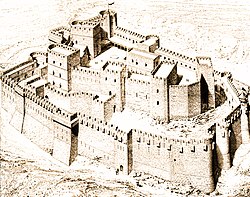Concentric castle

A concentric castle (or multiple castle) is a castle within a castle, with two or more concentric rings of curtain walls and, in cases, no central keep.[1] Generally, the outermost walls are lowest and the height of the walls increases towards the centre. The walls would include towers and bastions and would usually be crenellated. Gates would usually be protected by barbicans.
Development history
Concentric castles were introduced into Europe in the 14th century following the Crusades[2] and were designed to increase the defensive capabilities of the castle: defenders on the higher walls towards the centre could fire arrows at the enemy over the lower outer defences, and, should the enemy capture the outer defences, they would face another line of defence.

The Krak des Chevaliers Crusader castle in Syria and Beaumaris Castle[3] in Wales are excellent examples of this type of fortification.
In terms of development, the concentric castle is the descendant of shell keeps and co-existed with linear castles, which tended to be built where geography precluded concentric rings or naturally favoured a linear approach to castle-building.
References
- ^ "Concentric Castles". Retrieved 2007-02-04.
- ^ "Castle Learning Center: Concentric Castles". Retrieved 2007-02-04.
- ^ "Layout of Beaumaris Castle". Retrieved 2007-02-04.
External links
- Concentric Castle 3D graphical depiction
